Yiwei Li
RAU: Reference-based Anatomical Understanding with Vision Language Models
Sep 26, 2025Abstract:Anatomical understanding through deep learning is critical for automatic report generation, intra-operative navigation, and organ localization in medical imaging; however, its progress is constrained by the scarcity of expert-labeled data. A promising remedy is to leverage an annotated reference image to guide the interpretation of an unlabeled target. Although recent vision-language models (VLMs) exhibit non-trivial visual reasoning, their reference-based understanding and fine-grained localization remain limited. We introduce RAU, a framework for reference-based anatomical understanding with VLMs. We first show that a VLM learns to identify anatomical regions through relative spatial reasoning between reference and target images, trained on a moderately sized dataset. We validate this capability through visual question answering (VQA) and bounding box prediction. Next, we demonstrate that the VLM-derived spatial cues can be seamlessly integrated with the fine-grained segmentation capability of SAM2, enabling localization and pixel-level segmentation of small anatomical regions, such as vessel segments. Across two in-distribution and two out-of-distribution datasets, RAU consistently outperforms a SAM2 fine-tuning baseline using the same memory setup, yielding more accurate segmentations and more reliable localization. More importantly, its strong generalization ability makes it scalable to out-of-distribution datasets, a property crucial for medical image applications. To the best of our knowledge, RAU is the first to explore the capability of VLMs for reference-based identification, localization, and segmentation of anatomical structures in medical images. Its promising performance highlights the potential of VLM-driven approaches for anatomical understanding in automated clinical workflows.
Memory Enhanced Fractional-Order Dung Beetle Optimization for Photovoltaic Parameter Identification
Aug 09, 2025Abstract:Accurate parameter identification in photovoltaic (PV) models is crucial for performance evaluation but remains challenging due to their nonlinear, multimodal, and high-dimensional nature. Although the Dung Beetle Optimization (DBO) algorithm has shown potential in addressing such problems, it often suffers from premature convergence. To overcome these issues, this paper proposes a Memory Enhanced Fractional-Order Dung Beetle Optimization (MFO-DBO) algorithm that integrates three coordinated strategies. Firstly, fractional-order (FO) calculus introduces memory into the search process, enhancing convergence stability and solution quality. Secondly, a fractional-order logistic chaotic map improves population diversity during initialization. Thirdly, a chaotic perturbation mechanism helps elite solutions escape local optima. Numerical results on the CEC2017 benchmark suite and the PV parameter identification problem demonstrate that MFO-DBO consistently outperforms advanced DBO variants, CEC competition winners, FO-based optimizers, enhanced classical algorithms, and recent metaheuristics in terms of accuracy, robustness, convergence speed, while also maintaining an excellent balance between exploration and exploitation compared to the standard DBO algorithm.
Kimi K2: Open Agentic Intelligence
Jul 28, 2025Abstract:We introduce Kimi K2, a Mixture-of-Experts (MoE) large language model with 32 billion activated parameters and 1 trillion total parameters. We propose the MuonClip optimizer, which improves upon Muon with a novel QK-clip technique to address training instability while enjoying the advanced token efficiency of Muon. Based on MuonClip, K2 was pre-trained on 15.5 trillion tokens with zero loss spike. During post-training, K2 undergoes a multi-stage post-training process, highlighted by a large-scale agentic data synthesis pipeline and a joint reinforcement learning (RL) stage, where the model improves its capabilities through interactions with real and synthetic environments. Kimi K2 achieves state-of-the-art performance among open-source non-thinking models, with strengths in agentic capabilities. Notably, K2 obtains 66.1 on Tau2-Bench, 76.5 on ACEBench (En), 65.8 on SWE-Bench Verified, and 47.3 on SWE-Bench Multilingual -- surpassing most open and closed-sourced baselines in non-thinking settings. It also exhibits strong capabilities in coding, mathematics, and reasoning tasks, with a score of 53.7 on LiveCodeBench v6, 49.5 on AIME 2025, 75.1 on GPQA-Diamond, and 27.1 on OJBench, all without extended thinking. These results position Kimi K2 as one of the most capable open-source large language models to date, particularly in software engineering and agentic tasks. We release our base and post-trained model checkpoints to facilitate future research and applications of agentic intelligence.
Mind the Quote: Enabling Quotation-Aware Dialogue in LLMs via Plug-and-Play Modules
May 30, 2025Abstract:Human-AI conversation frequently relies on quoting earlier text-"check it with the formula I just highlighted"-yet today's large language models (LLMs) lack an explicit mechanism for locating and exploiting such spans. We formalise the challenge as span-conditioned generation, decomposing each turn into the dialogue history, a set of token-offset quotation spans, and an intent utterance. Building on this abstraction, we introduce a quotation-centric data pipeline that automatically synthesises task-specific dialogues, verifies answer correctness through multi-stage consistency checks, and yields both a heterogeneous training corpus and the first benchmark covering five representative scenarios. To meet the benchmark's zero-overhead and parameter-efficiency requirements, we propose QuAda, a lightweight training-based method that attaches two bottleneck projections to every attention head, dynamically amplifying or suppressing attention to quoted spans at inference time while leaving the prompt unchanged and updating < 2.8% of backbone weights. Experiments across models show that QuAda is suitable for all scenarios and generalises to unseen topics, offering an effective, plug-and-play solution for quotation-aware dialogue.
Silencer: From Discovery to Mitigation of Self-Bias in LLM-as-Benchmark-Generator
May 27, 2025Abstract:LLM-as-Benchmark-Generator methods have been widely studied as a supplement to human annotators for scalable evaluation, while the potential biases within this paradigm remain underexplored. In this work, we systematically define and validate the phenomenon of inflated performance in models evaluated on their self-generated benchmarks, referred to as self-bias, and attribute it to sub-biases arising from question domain, language style, and wrong labels. On this basis, we propose Silencer, a general framework that leverages the heterogeneity between multiple generators at both the sample and benchmark levels to neutralize bias and generate high-quality, self-bias-silenced benchmark. Experimental results across various settings demonstrate that Silencer can suppress self-bias to near zero, significantly improve evaluation effectiveness of the generated benchmark (with an average improvement from 0.655 to 0.833 in Pearson correlation with high-quality human-annotated benchmark), while also exhibiting strong generalizability.
AdCare-VLM: Leveraging Large Vision Language Model (LVLM) to Monitor Long-Term Medication Adherence and Care
May 01, 2025Abstract:Chronic diseases, including diabetes, hypertension, asthma, HIV-AIDS, epilepsy, and tuberculosis, necessitate rigorous adherence to medication to avert disease progression, manage symptoms, and decrease mortality rates. Adherence is frequently undermined by factors including patient behavior, caregiver support, elevated medical costs, and insufficient healthcare infrastructure. We propose AdCare-VLM, a specialized Video-LLaVA-based multimodal large vision language model (LVLM) aimed at visual question answering (VQA) concerning medication adherence through patient videos. We employ a private dataset comprising 806 custom-annotated tuberculosis (TB) medication monitoring videos, which have been labeled by clinical experts, to fine-tune the model for adherence pattern detection. We present LLM-TB-VQA, a detailed medical adherence VQA dataset that encompasses positive, negative, and ambiguous adherence cases. Our method identifies correlations between visual features, such as the clear visibility of the patient's face, medication, water intake, and the act of ingestion, and their associated medical concepts in captions. This facilitates the integration of aligned visual-linguistic representations and improves multimodal interactions. Experimental results indicate that our method surpasses parameter-efficient fine-tuning (PEFT) enabled VLM models, such as LLaVA-V1.5 and Chat-UniVi, with absolute improvements ranging from 3.1% to 3.54% across pre-trained, regular, and low-rank adaptation (LoRA) configurations. Comprehensive ablation studies and attention map visualizations substantiate our approach, enhancing interpretability.
Task-Specific Knowledge Distillation from the Vision Foundation Model for Enhanced Medical Image Segmentation
Mar 10, 2025Abstract:Large-scale pre-trained models, such as Vision Foundation Models (VFMs), have demonstrated impressive performance across various downstream tasks by transferring generalized knowledge, especially when target data is limited. However, their high computational cost and the domain gap between natural and medical images limit their practical application in medical segmentation tasks. Motivated by this, we pose the following important question: "How can we effectively utilize the knowledge of large pre-trained VFMs to train a small, task-specific model for medical image segmentation when training data is limited?" To address this problem, we propose a novel and generalizable task-specific knowledge distillation framework. Our method fine-tunes the VFM on the target segmentation task to capture task-specific features before distilling the knowledge to smaller models, leveraging Low-Rank Adaptation (LoRA) to reduce the computational cost of fine-tuning. Additionally, we incorporate synthetic data generated by diffusion models to augment the transfer set, enhancing model performance in data-limited scenarios. Experimental results across five medical image datasets demonstrate that our method consistently outperforms task-agnostic knowledge distillation and self-supervised pretraining approaches like MoCo v3 and Masked Autoencoders (MAE). For example, on the KidneyUS dataset, our method achieved a 28% higher Dice score than task-agnostic KD using 80 labeled samples for fine-tuning. On the CHAOS dataset, it achieved an 11% improvement over MAE with 100 labeled samples. These results underscore the potential of task-specific knowledge distillation to train accurate, efficient models for medical image segmentation in data-constrained settings.
Speculative Decoding for Multi-Sample Inference
Mar 07, 2025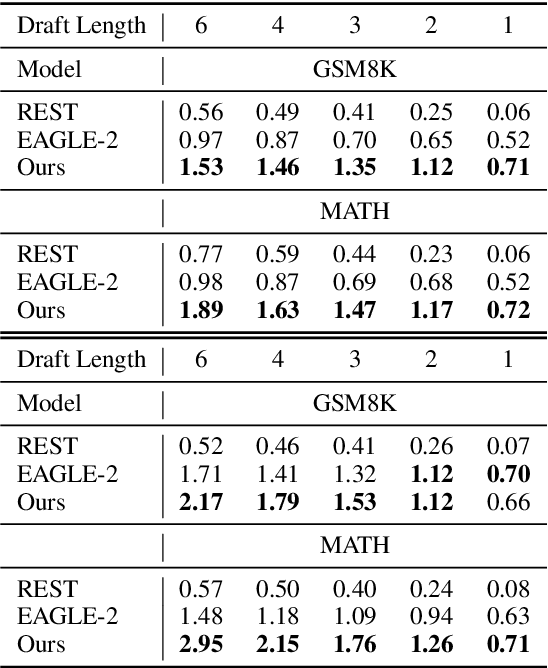
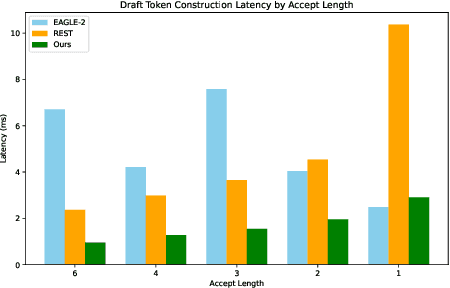
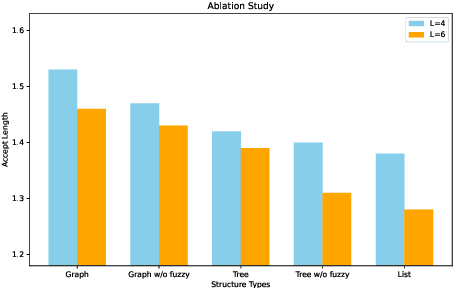
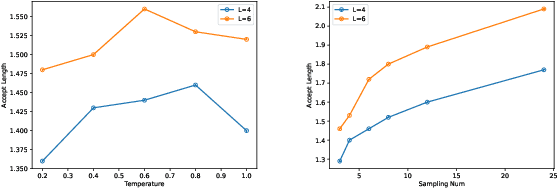
Abstract:We propose a novel speculative decoding method tailored for multi-sample reasoning scenarios, such as self-consistency and Best-of-N sampling. Our method exploits the intrinsic consensus of parallel generation paths to synthesize high-quality draft tokens without requiring auxiliary models or external databases. By dynamically analyzing structural patterns across parallel reasoning paths through a probabilistic aggregation mechanism, it identifies consensus token sequences that align with the decoding distribution. Evaluations on mathematical reasoning benchmarks demonstrate a substantial improvement in draft acceptance rates over baselines, while reducing the latency in draft token construction. This work establishes a paradigm shift for efficient multi-sample inference, enabling seamless integration of speculative decoding with sampling-based reasoning techniques.
Semantic Prior Distillation with Vision Foundation Model for Enhanced Rapid Bone Scintigraphy Image Restoration
Mar 04, 2025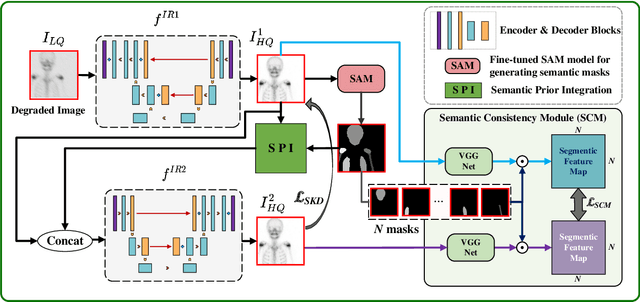
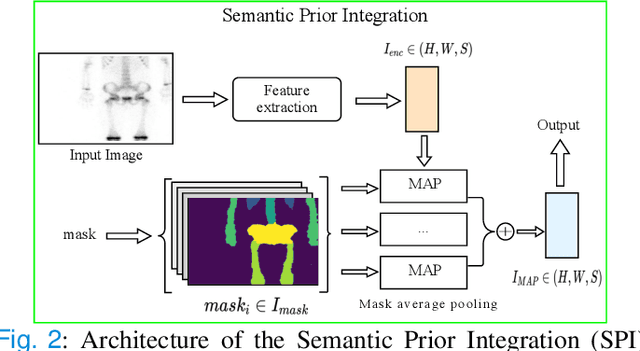

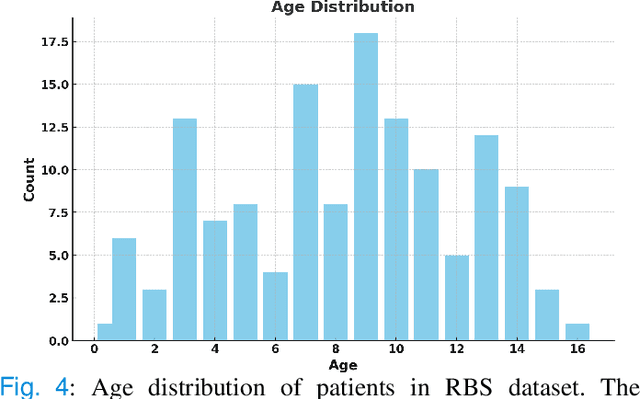
Abstract:Rapid bone scintigraphy is an essential tool for diagnosing skeletal diseases and tumor metastasis in pediatric patients, as it reduces scan time and minimizes patient discomfort. However, rapid scans often result in poor image quality, potentially affecting diagnosis due to reduced resolution and detail, which make it challenging to identify and evaluate finer anatomical structures. To address this issue, we propose the first application of SAM-based semantic priors for medical image restoration, leveraging the Segment Anything Model (SAM) to enhance rapid bone scintigraphy images in pediatric populations. Our method comprises two cascaded networks, $f^{IR1}$ and $f^{IR2}$, augmented by three key modules: a Semantic Prior Integration (SPI) module, a Semantic Knowledge Distillation (SKD) module, and a Semantic Consistency Module (SCM). The SPI and SKD modules incorporate domain-specific semantic information from a fine-tuned SAM, while the SCM maintains consistent semantic feature representation throughout the cascaded networks. In addition, we will release a novel Rapid Bone Scintigraphy dataset called RBS, the first dataset dedicated to rapid bone scintigraphy image restoration in pediatric patients. RBS consists of 137 pediatric patients aged between 0.5 and 16 years who underwent both standard and rapid bone scans. The dataset includes scans performed at 20 cm/min (standard) and 40 cm/min (rapid), representing a $2\times$ acceleration. We conducted extensive experiments on both the publicly available endoscopic dataset and RBS. The results demonstrate that our method outperforms all existing methods across various metrics, including PSNR, SSIM, FID, and LPIPS.
Revisiting Self-Consistency from Dynamic Distributional Alignment Perspective on Answer Aggregation
Feb 27, 2025Abstract:Self-consistency improves reasoning by aggregating diverse stochastic samples, yet the dynamics behind its efficacy remain underexplored. We reframe self-consistency as a dynamic distributional alignment problem, revealing that decoding temperature not only governs sampling randomness but also actively shapes the latent answer distribution. Given that high temperatures require prohibitively large sample sizes to stabilize, while low temperatures risk amplifying biases, we propose a confidence-driven mechanism that dynamically calibrates temperature: sharpening the sampling distribution under uncertainty to align with high-probability modes, and promoting exploration when confidence is high. Experiments on mathematical reasoning tasks show this approach outperforms fixed-diversity baselines under limited samples, improving both average and best-case performance across varying initial temperatures without additional data or modules. This establishes self-consistency as a synchronization challenge between sampling dynamics and evolving answer distributions.
 Add to Chrome
Add to Chrome Add to Firefox
Add to Firefox Add to Edge
Add to Edge